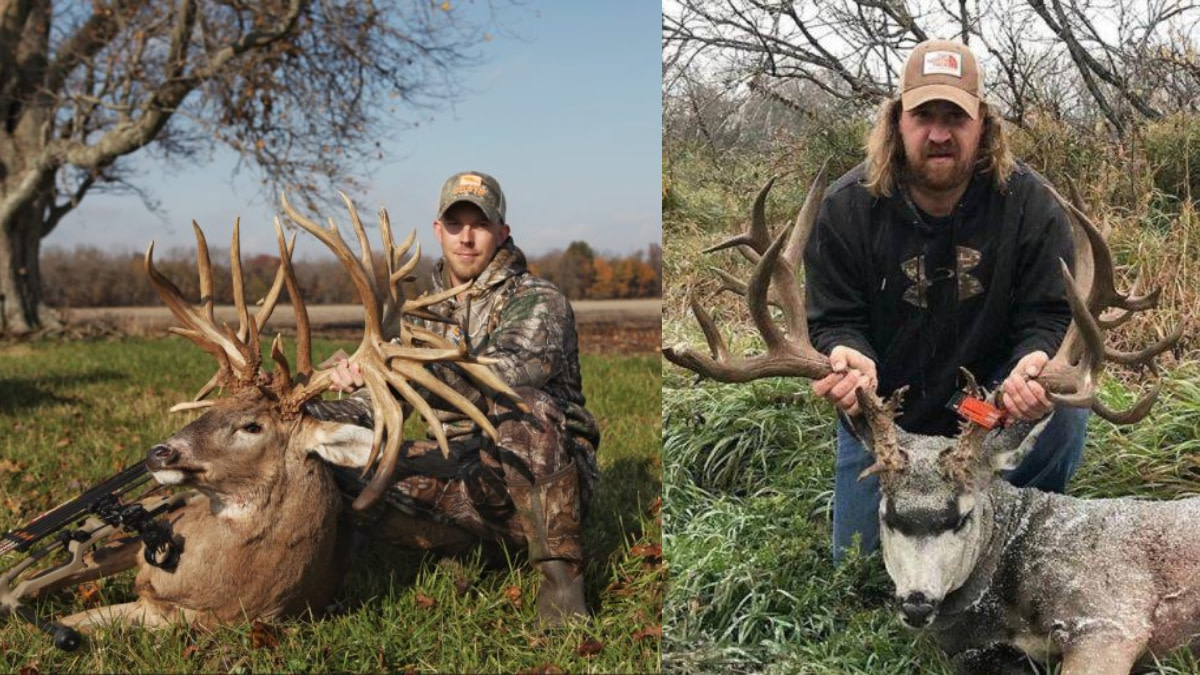
On Jan. 5, a small group of men gathered around an exceptional whitetail rack in Illinois. With measuring tape in hand, they spent the next three hours tallying up the inches of antler. Luke Brewster, the hunter responsible for arrowing the deer, sat impatiently, waiting for the results. It had been two months since he tagged the whitetail, but these final moments were weighing heavily on his mind.
“It was pretty nerve wracking,” Brewster said in an interview with North American Whitetail. “I started worrying almost the whole time, but it went pretty well.”
When the official scorers emerged with a number, they confirmed what Brewster and his buddies had hoped: This was the new world record non-typical whitetail. At 320 5/8 inches, Brewster’s Illinois buck beat the old record by nearly 8 inches.
Four days later, a group of scorers shared similar news with a hunter in Saskatchewan. Dennis Bennett, who shot an enormous mule deer on Oct. 1, found out that his harvest shattered the old archery record for non-typical mule deer. With a score of 291 1/8, Bennett beat the 21-year-old record by more than 16 inches.
Eli Randall, records director for the Pope and Young Club, was in attendance when the Bennett buck was measured. He called the deer a “must see.”
“It was a pleasure to be part of the panel recognizing this beautiful non-typical mule deer from Saskatchewan as a new world record,” Randall said in an interview with Bucks, Bulls & Bears. “The pictures of this deer do not do it justice.”
Record Keeping
The Boone and Crockett Club began keeping big game records a century ago. Today, most hunters view the record books as a bragging board where elite North American specimens are honored. However, B&C’s original intent was based in conservation.
In the 1920s, the club called on member Prentiss Gray to help create an official scoring system for big game. The group wanted to establish measurements for species they considered to be vanishing. State and federal agencies quickly realized this was an effective way to track the success of new conservation polices, and many began implementing the scoring system in their own surveys.
“Population data shows that conservation practices have had a dramatic, positive effect on the abundance of wildlife in our country,” according to B&C. “The growing populations of big game and associated wildlife stand as a testament to the foresight of club members.”
B&C also did a great job of uniting hunters, which didn’t go unnoticed by the National Field Archery Association. Looking to replicate B&C’s camaraderie, the NFAA requested permission in 1958 to use the same scoring system. A few years later, Pope & Young was born.
“Response to the club was immediate, positive and gratifying,” according to P&Y. “We knew we had a winner from the beginning.”
Record Breaking
If it seems like record breaking animals are coming at a greater pace these days, that’s because they are. Of the 34 North American animals that P&Y tracks, 17 have had records broken within the last decade. Along with the new non-typical mule deer and whitetail deer records, there have been recent entries for Coues deer, woodland caribou, American elk, Shiras moose, desert bighorn sheep and more.
A major contributing factor for this run of record breaking harvests is that archery technology is far superior to what it was just 10 years ago, let alone 50 years ago. Tony Peterson, equipment editor for Bowhunter Magazine, has witnessed the archery revolution firsthand.
“Pretty much every gear category that a bowhunter would be concerned with has evolved in the last 25 years,” Peterson said. “Hub-style ground blinds, trail cameras, lighted nocks and food plots are a few examples of new tools we have at our disposal that simply weren’t an option a few decades ago, and they’ve completely changed the game.”
The leap in technology has been most noticeable for those who target North America’s most popular big game.
“A whitetail hunter in the ’90s wouldn’t have believed you could monitor the woods 24/7 while receiving up-to-the-minute photos of bucks munching clover in a customizable destination food source. But that’s common today,” Peterson said.
The direction of archery technology is likely a reflection of how hunting culture has changed. It’s no accident that there are bigger bucks across the continent.
According to the Quality Deer Management Association’s Whitetail Report, 2018 is the fifth straight year that the amount of yearling bucks killed has decreased. Making up just 35 percent of annual harvest, there are fewer yearling bucks being harvested than at any point in modern history. As a natural result, there are more mature bucks being killed than ever before. In 2018, 34 percent of bucks tagged were 3.5 years old or older.
“Under a trend like that, a lot of hunters everywhere are enjoying their best deer hunting ever without measuring antler inches or coming anywhere near record books,” said Lindsay Thomas, director of communications for QDMA. “But certainly in the areas with the best soils, habitat and genetics to grow very large whitetails, it stands to reason that a by-product is that records are going to be broken more frequently.”
The Future
It’s a safe bet that this trend is going to continue. When Luke Brewster’s buck was officially recognized as the world’s biggest whitetail, it hadn’t even been two years since B&C made the same announcement regarding a buck in Tennessee.
Stephen Tucker, the hunter who previously held the whitetail record, was featured in Field & Stream, where his buck was called “the deer story of the decade.” Although Brewster’s whitetail has stolen that title, no one would be surprised if the deer story of the decade is rewritten again soon.
Feature image via Luke Brewster and Dennis Bennett.





